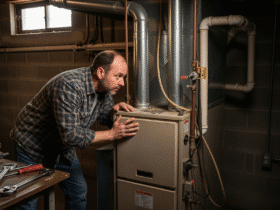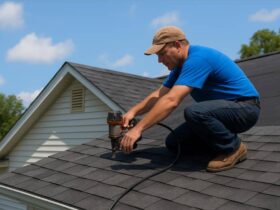Key Takeaways
- Modern roofing includes energy-efficient and sustainable innovations, offering homeowners greater protection and long-term value.
- Staying updated on material advances, regulatory trends, and innovative tech can increase curb appeal and help protect property investments.
- Routine upkeep and working with qualified professionals are critical for extending the life and performance of all roof types.
- Eco-friendly materials and integrated technologies are changing homeownership expectations for roofs.
Table of Contents
- Emerging Roofing Trends, Homeowners Should Know
- Energy-Efficient Roofing Solutions
- Sustainable Roofing Materials And Environmental Impact
- Prioritizing Roof Maintenance and Preventive Care
- How Smart Technology Is Changing Residential Roofs
- Staying Compliant: Building Codes and Roofing Standards
- Top Tips for Homeowners Planning a New Roof
- Additional Resources on Innovative Roofing
Emerging Roofing Trends, Homeowners Should Know
Residential roofing has evolved far beyond simple asphalt shingles and utilitarian styles. For today’s homeowners, the roof is not just a line of defense—it’s a statement piece and a driver of efficiency. Trends over the past several years highlight a shift toward aesthetics and performance, with homeowners seeking solutions that are as visually appealing as they are reliable. The expanding options include bold architectural shingles, lightweight yet durable synthetic slate, and even rooftop gardens, known as living or green roofs, which bring beauty and environmental benefits to a property. What was once reserved for high-end properties is now accessible to more homeowners, mainly due to advances in manufacturing and installation methods recommended by a professional McLean VA roofing contractor.
As noted in Architectural Digest’s review of popular roofing materials, styles like metal standing seam roofs and designer composite shingles are quickly gaining favor for their ability to mimic high-end finishes with less maintenance and a longer lifespan. In addition, the push for increased curb appeal means color choices have broadened, and textures can be customized. Real-life applications are plentiful—for example, modern farmhouse builds now opt for matte-black metal roofs, while some eco-friendly new constructions incorporate rooftop gardens for added insulation. With these dynamic options, the modern roof is more about personal expression than home protection.
Energy-Efficient Roofing Solutions
Energy efficiency is rapidly becoming a key feature that homebuyers and owners seek when upgrading or replacing their roofs. Traditional dark shingles absorb heat and drive up indoor cooling bills, especially during peak summer months. Modern energy-efficient options such as cool roofs, which feature specially engineered reflective coatings or lighter-colored membranes, can reflect a significant portion of sunlight. The U.S. Department of Energy reports that cool roofs may reduce surface temperature by up to 50°F, potentially delivering up to 15% annual savings on cooling costs.
Another transformative approach involves integrating solar shingles or panels. These generate electricity—offsetting monthly utility costs and reducing a household’s carbon footprint—and may qualify homeowners for federal and state tax credits. Durable roofing options such as insulated metal panels or engineered tiles are gaining momentum thanks to their ability to help regulate interior temperatures through superior insulation. Even for homes in colder regions, enhanced roof insulation, snow-shedding designs, and smarter underlayments provide better energy retention and comfort. The move to install energy-efficient technology in roofing is not just about savings; it’s a proactive response to climate change and a step toward future-ready living.
Sustainable Roofing Materials And Environmental Impact
As building trends move toward sustainability, roofing materials have kept pace. Many homeowners now look for products with recycled content or renewable and long-lasting materials. For example, metal roofs often contain 25-95% recycled content and can be recycled entirely at the end of their lifespan. Composite shingles from recycled plastics, rubber, and wood fibers offer resilience and an eco-friendly footprint. Clay and slate tiles, while more traditional, can last over a century with minimal maintenance, eliminating the cycle of frequent replacement.
Living roofs—green spaces installed directly onto the building structure—are gaining traction in urban environments, where they provide much-needed insulation, reduce the heat island effect, and even support local biodiversity by creating habitats for birds and pollinators. Proper design with the help of knowledgeable professionals ensures these systems thrive and last. Some municipalities offer rebates or incentives to homeowners who select sustainable roofing systems, encouraging this environmentally responsible trend. By choosing sustainable materials and installation, homeowners can tangibly lower their environmental impact, boost the durability of their roof, and sometimes even increase their property’s market appeal.
Prioritizing Roof Maintenance and Preventive Care
A new roof is a significant investment but requires consistent attention to deliver long-term value. Preventive care and routine inspections are fundamental, especially as extreme weather events become more common and unpredictable. Starting with seasonal tasks—like removing leaves and debris, clearing gutters, and checking for standing water—can go a long way. Regularly examining shingles for cracking or curling and ensuring adequate attic ventilation can prevent premature deterioration and structural issues.
Extensive research within the roofing industry shows that regular inspections—conducted annually or semi-annually by certified professionals—significantly extend a roof’s lifespan, often up to 30%, compared to poorly maintained roofs. These inspections focus on critical, high-risk areas such as flashing around chimneys, skylights, vents, and vulnerable seams at valleys, where water intrusion commonly begins. Catching minor issues early allows for affordable repairs that prevent widespread damage. These minor problems can escalate into major structural concerns, including leaks, mold growth, and insulation deterioration, when ignored. Beyond protecting the home’s physical integrity, routine inspections also help meet insurance requirements, as many providers mandate documentation to validate coverage, especially in weather-related claims or unexpected roof failures.
How Smart Technology Is Changing Residential Roofs
Technological innovations significantly transform the residential roofing industry, making roof management more efficient, proactive, and intelligent. Today’s advanced home monitoring systems can detect leaks, monitor humidity levels, and assess structural integrity using real-time data. These innovative systems allow homeowners to catch minor issues—such as slow moisture buildup or early signs of damage—before they escalate into expensive repairs. Many of these systems are equipped with roof-integrated sensors that connect to mobile apps, offering instant alerts and updates regardless of the homeowner’s location.
Technology integration doesn’t stop at monitoring; it also enhances the inspection and installation process. Roofing professionals now utilize drones with high-definition cameras to conduct aerial inspections, capturing detailed images of a roof’s surface without ladders or scaffolding. This reduces risk while improving accuracy in identifying areas needing attention. Some systems allow homeowners to monitor solar panels’ energy output and performance, helping them maximize efficiency and savings. Collectively, these technologies represent a new standard in home maintenance, where data, automation, and remote accessibility enable smarter, safer, and more sustainable roof care for the modern homeowner.
Staying Compliant: Building Codes and Roofing Standards
Every region has building codes and roofing regulations to protect properties and ensure public safety. These codes frequently change to accommodate technological advances and local climate considerations. In hurricane-prone zones, for instance, rules often mandate higher wind ratings and secure fastening methods, while wildfire-prone areas require fire-resistant roofing materials. Inspections and permits may include requirements for underlayment type, ventilation standards, and energy efficiency metrics.
Successfully managing roofing requirements is most effective when homeowners collaborate with local professionals who are well-versed in municipal codes and how they apply to modern roofing technologies. These experts understand the intricacies of permitting processes and ensure compliance with legal and safety standards. Building permits are not just bureaucratic steps—they provide essential safeguards for homeowners by verifying that materials and installation methods meet regulatory expectations. Ignoring these requirements can lead to serious consequences, including fines, delays, or the potential denial of insurance claims after storm damage or structural failure. Partnering with knowledgeable contractors who stay current with evolving codes helps protect a homeowner’s investment while ensuring long-term property value and resilience.
Top Tips for Homeowners Planning a New Roof
- Ask about the longevity, maintenance needs, and total lifecycle cost of all material options being considered.
- Request real-world samples of innovative materials, such as cool roofing or integrated solar shingles, to see how they look and feel in person before committing.
- Hire only fully insured, licensed, and experienced roofing contractors with a substantial code compliance and artistry quality track record.
- Don’t wait for visible damage to schedule inspections; set up an annual or semi-annual check-in with a trusted professional to catch issues early.
- Calculate the long-term return on investment by weighing initial outlays against future savings from incentives, rebates, and ongoing energy reductions.
- Consider local climate—choose materials designed to resist wind, rain, snow, or extreme heat based on your area’s weather profile.
Additional Resources on Innovative Roofing
Staying informed about the continuous advancements in residential roofing is essential for homeowners who want to make smart, future-ready decisions. With rapid developments in materials, technology, and sustainability standards, having access to accurate, up-to-date information helps property owners remain prepared and competitive. Following industry trends allows homeowners to explore emerging roofing options like energy-efficient shingles, recycled materials, and solar-integrated systems and better understand how building codes and climate considerations affect roofing performance. Trusted publications such as Architectural Digest offer insightful updates on design movements and innovative materials influencing residential architecture across various regions. These curated insights provide valuable context for homeowners planning upgrades or new installations. Consulting with experienced roofing professionals also ensures that technical specifications, warranties, and installation practices align with long-term comfort, energy savings, and aesthetic appeal. When homeowners combine diligent research with expert advice, they are well-positioned to choose roofing solutions that protect their investment and enhance the beauty and efficiency of their homes for years to come.








